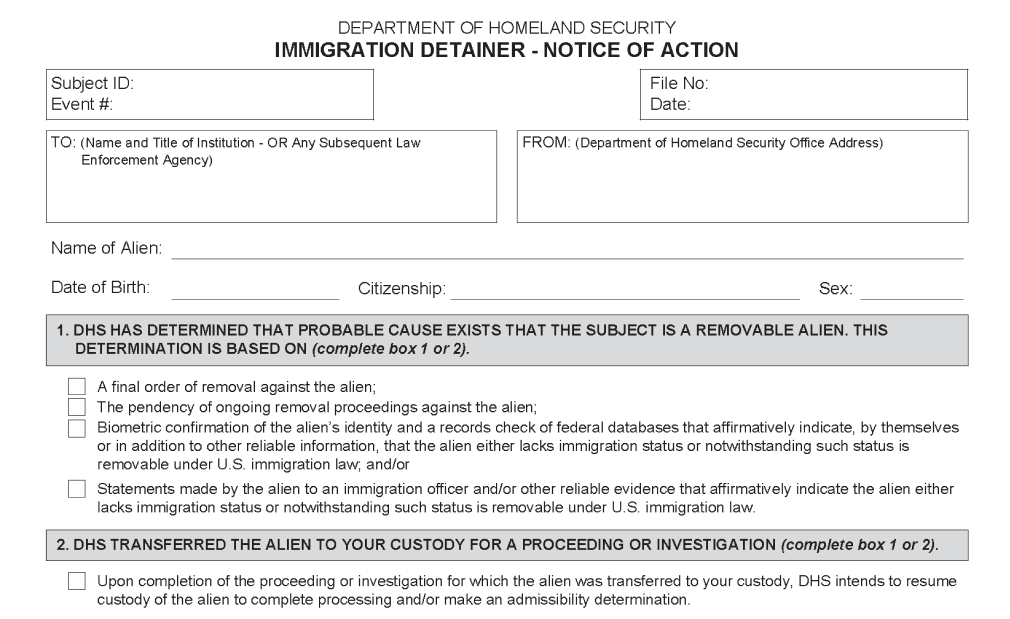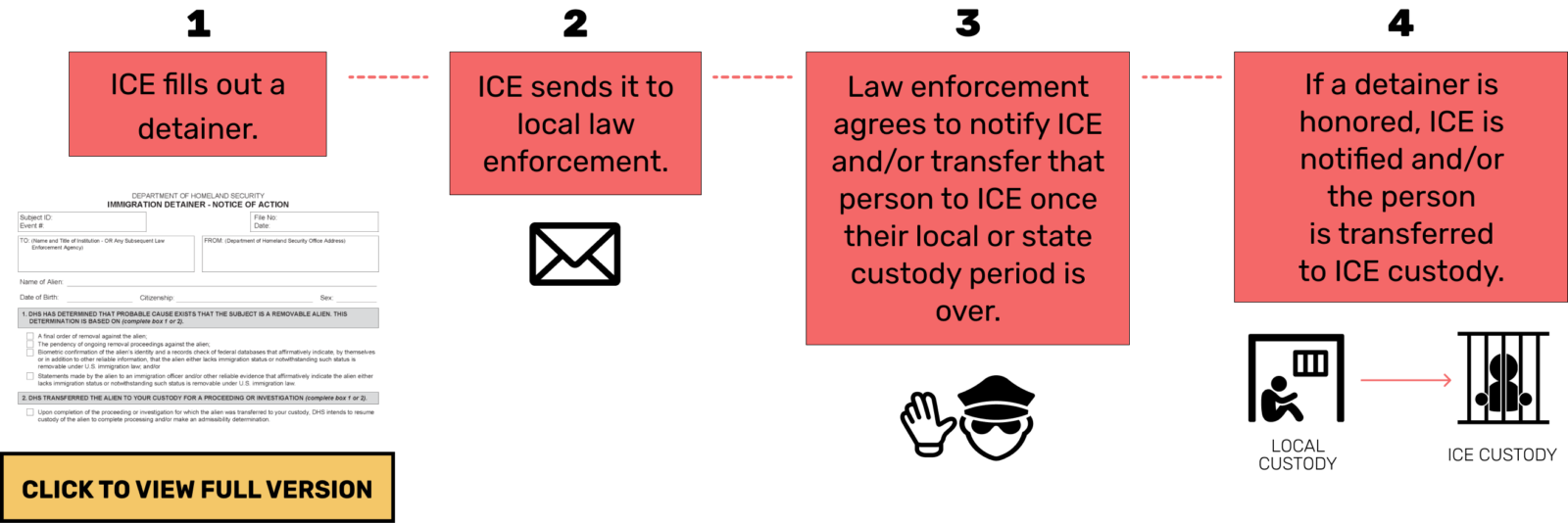Check the Detainer Laws in Your Area!
Local law enforcement agencies have different policies about whether they will work with ICE.
Contact a local immigrant rights organization to learn more about local laws and policies related to ICE detainers. These organizations can help you find an immigration attorney, give you advice about your immigration situation, or help advocate with ICE.
A detainer is a form from Immigration and Customs Enforcement (ICE) that asks law enforcement to hold you in criminal custody, even if you should be released. It also asks law enforcement to notify ICE before you are released from criminal custody.
ICE might send a detainer to offices such as the sheriff, the police, a jail, or a prison.
Detainers are also called “ICE holds” or “immigration holds.”
How an ICE Detainer Works

ICE issues a detainer form when ICE believes you are not a U.S. citizen and could be deported from the U.S. You could be deported if you are undocumented, have lawful status and certain convictions, have violated the terms of your immigration status, or for reasons related to “national security.”
If ICE believes that you may be deported from the U.S., ICE issues a detainer form to the local jail, prison, or police. When a jail or prison decides to follow the requests in the detainer form, they might transfer you directly to ICE custody, or hold you at the jail or prison until ICE can come to arrest you.
ICE can learn about you when you are fingerprinted during an arrest by local police. The police or sheriff share fingerprint data and other arrest information with ICE. Police may also call ICE directly if they suspect you are not a U.S. citizen.

The ICE detainer form asks the jail to hold you for up to 48 hours after you are finished with your criminal custody. In the past, weekends and holidays were not included in the 48 hours, but now they are included in the 48 hours.
The ICE detainer form says that you must be released after 48 hours if ICE does not pick you up. The jail might mistakenly insist that they have to hold you for more time until ICE comes to arrest you.
When law enforcement offices cooperate with ICE detainers, they make it easier for ICE to arrest people. Following an ICE detainer request is voluntary and local law enforcement can decide whether or not to comply. This means the federal government cannot force the police, jail, or prison to hold you for ICE because of an ICE detainer. If a city or state has a policy that they will not follow detainer requests, the local jail might not transfer or hold you for ICE.
What Can I Do About an ICE Detainer?
1. You or your loved one can contact the local public defender office, your criminal defense attorney, or a local immigrant rights organization:
- Before asking for bail
- Before paying bail
- For help asking to be released from jail, especially if you paid bail, your case was dismissed, or you have finished your sentence
2. If you feel comfortable, you or someone else can ask the jail to release you.
3. Speak with a local public defender or immigrant rights organization about filing a motion in court for your release from jail.
4. Talk to an immigration attorney to get advice about your immigration situation and options. You or your loved ones can look for a trusted immigration attorney or representative on the Immigration Advocates Network legal directory.
How Can an ICE Detainer Affect Me?
There are many factors that affect your eligibility for bail. A criminal defense attorney can give you more advice about your situation, including whether a detainer will affect your release from criminal custody.
If there is an ICE detainer filed against you, you should speak to your criminal defense attorney or local public defender office before paying bail. The attorney can help you understand any risks in paying bail. For example, if you pay bail and the jail cooperates with ICE, they may keep you in criminal custody for up to 48 hours so ICE can arrest you.
If you are arrested by ICE, you may not be able to physically appear for your criminal case and defend yourself against the charges. The judge might issue a warrant against you for not attending your criminal court hearing. This could impact your criminal case and whether you get your bail money back.
A jail might not release you because of an ICE detainer, even after you pay bail. They could hold you for up to 48 hours for ICE to arrest you. Some jails may keep you in criminal custody until ICE comes, even if this takes longer than 48 hours.
An ICE detainer may interfere with your release at the end of a sentence. If the jail or prison decides to follow a detainer request, you would be held for up to 48 hours so ICE can arrest you.
An ICE detainer may interfere with your release even if all charges against you have been dismissed. If the jail or prison decides to follow a detainer request, you could be held for up to 48 hours so ICE can arrest you.
Check the Detainer Laws in Your Area!
Your location could have different policies about cooperating with ICE. You might be able to use the local policy to explain to the jail that it is unlawful to hold you during or after the first 48 hours.
ICE Picked Me Up
ICE PICKED
ME UP
If ICE arrests you from criminal custody, you may be taken to an ICE processing center. ICE will decide whether to put you in a detention center or release you. You could be held in any immigration detention center throughout the country. The ICE detainee locator has information about where a person is detained by ICE.
During this process, ICE will ask you questions about your immigration and criminal history. Any information you share with an ICE officer, including place of birth, can be used against you.
You or your loved one should talk to an immigration attorney to get advice about your immigration situation, options for release from detention under bond, and defenses to deportation.

Unless your case is dismissed or you have completed your sentence for the case, your criminal court case will stay open even while you are fighting your immigration case.
Your criminal defense attorney might not know that you are in immigration detention. You or your loved one should contact your criminal defense attorney or local public defender to let them know where you are detained and to talk about your options for your criminal case.
Helpful Resources
- ICE Detainee Locator: Information about where a person is detained by ICE.
- Federal Bureau of Prisons Locator: Information to locate a person who is in federal prison.
- EOIR Automated Case Information Website: Information about past or future immigration court hearings.
- Immigration Advocates Network Legal Directory: A directory of immigration legal organizations across the country.
- National Bail Fund Network: A directory of community funds for help paying criminal bail and immigration bond.
- Florence Immigrant and Refugee Rights Project: Resources for how to defend yourself in immigration detention.
ICE Detainer FAQ
This resource was created for community members who have questions about an ICE detainer or immigration “hold” and are looking for information on what to do next.
ICE Detainer FAQ is also available in Spanish:
Órdenes De Retención Del Servicio De Inmigración Y Control De Aduanas “(“Ice” O “La Migra”): Preguntas frecuentes en Español.
Know Your Rights with ICE
Whether you are at home, on the street, or in your car, it is important to know your rights. You have rights even when ICE lies to you. See our Know Your Rights resources:
About IDP
The Immigrant Defense Project (IDP) was founded over 20 years ago to combat an emerging human rights crisis: the targeting of immigrants for mass imprisonment and deportation.
For more information and other resources, please visit immigrantdefenseproject.org (opens in a new tab).
